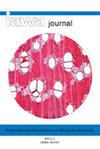Surviving in semi-arid environments: functional coordination and trade-offs in shrubs from Argentina
IF 3.5
3区 农林科学
Q2 FORESTRY
引用次数: 1
Abstract
Human action has led to an increase in aridification, making water a progressively scarcer resource. In angiosperms, different species resolve this challenge in diverse ways, mainly through modifications of the xylem network, which is responsible for water efficiency and safety. Xerophytes generally show similar characteristics, but exceptions are rather frequent. One possible explanation for this lack of similarity among cohabiting species is that trade-offs and/or functional coordination between their organs occur and shape alternative survival strategies. Studying species that inhabit a common area can help to identify key traits that determine those diverse strategies and to predict which species might tolerate further environmental change. We here examined the morpho-anatomical wood and bark traits of a group of species that live in a seasonally dry environment in Argentina. In a previous study, we described the leaf traits of these species and we thus aim to complement our findings and outline their strategies to manage water deficits. Our results show that there are different degrees of xeromorphism within this group. Clear xeromorphic traits, such as high vessel frequency and small diameter, were found in most species. However, some presented traits that were appropriate for mesic environments. An overview of leaf and wood traits indicates that the absence of a typical xeric characteristic in the wood might be compensated by the presence of a xeric leaf trait, and vice versa. Collectively, these trait combinations allow these species to survive in dry conditions and could influence their tolerance to increasing aridity.半干旱环境下的生存:阿根廷灌木的功能协调与权衡
人类活动导致了干旱化的加剧,使水资源变得越来越稀缺。在被子植物中,不同物种以不同的方式解决这一挑战,主要是通过木质部网络的修饰,木质部网络负责水的效率和安全性。苔藓植物通常表现出类似的特征,但例外情况相当频繁。同居物种之间缺乏相似性的一个可能解释是,它们的器官之间发生了权衡和/或功能协调,并形成了替代的生存策略。研究居住在共同区域的物种有助于确定决定这些不同策略的关键特征,并预测哪些物种可能容忍进一步的环境变化。我们在这里研究了生活在阿根廷季节性干旱环境中的一组物种的形态解剖木材和树皮特征。在之前的一项研究中,我们描述了这些物种的叶片特征,因此我们的目标是补充我们的发现,并概述他们管理缺水的策略。我们的结果表明,在这一组中存在不同程度的干态现象。大多数物种具有明显的旱形特征,如高导管频率和小直径。然而,一些人表现出了适合中位环境的特征。对叶片和木材特性的概述表明,木材中典型xeric特性的缺失可能会通过xeric叶片特性的存在来补偿,反之亦然。总的来说,这些性状组合使这些物种能够在干旱条件下生存,并可能影响它们对日益干旱的耐受性。
本文章由计算机程序翻译,如有差异,请以英文原文为准。
求助全文
约1分钟内获得全文
求助全文
来源期刊

IAWA Journal
农林科学-林学
CiteScore
3.40
自引率
15.80%
发文量
26
审稿时长
>36 weeks
期刊介绍:
The IAWA Journal is the only international periodical fully devoted to structure, function, identification and utilisation of wood and bark in trees, shrubs, lianas, palms, bamboo and herbs. Many papers are of a multidisciplinary nature, linking
 求助内容:
求助内容: 应助结果提醒方式:
应助结果提醒方式:


